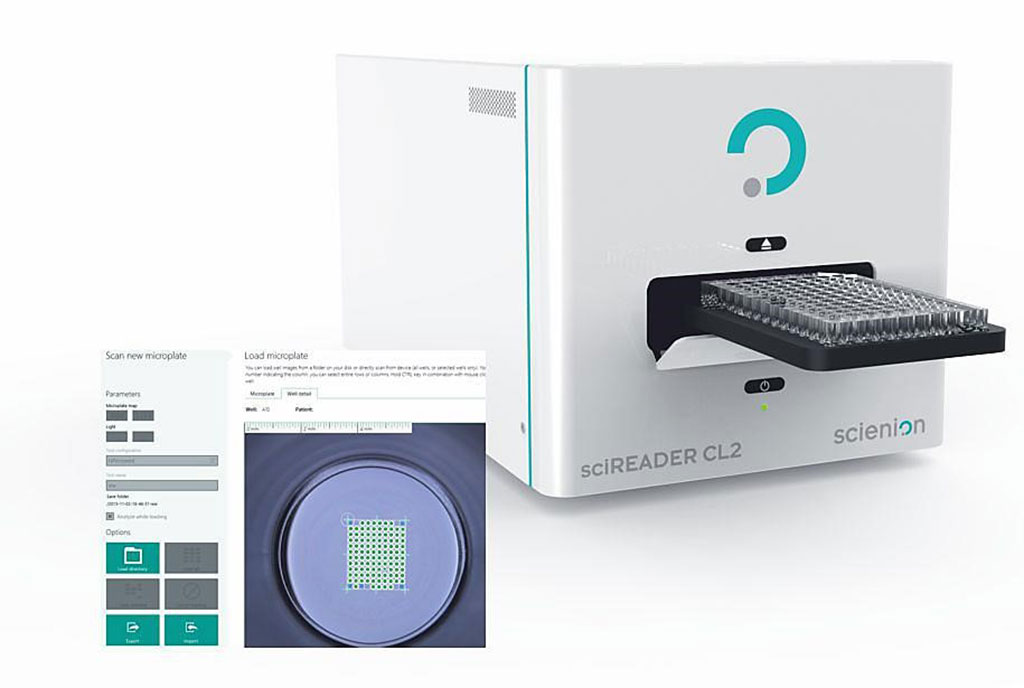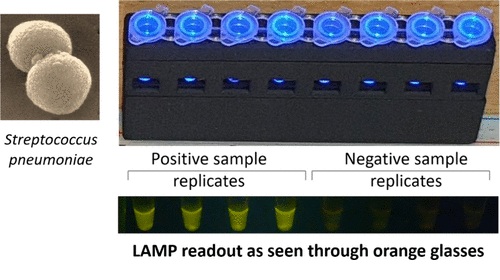Multiplex Immunoassay Developed for Confirmation and Typing of HTLV Infections
|
By LabMedica International staff writers Posted on 24 Nov 2021 |

Image: The sciREADER CL2 enables high quality digital colorimetric imaging of various support formats (Photo courtesy of SCIENION)
Human T-Cell Lymphotropic Viruses (HTLV) type 1 and type 2 account for an estimated five to 10 million infections worldwide and are transmitted through breast feeding, sexual contacts and contaminated cellular blood components.
HTLV-associated syndromes are considered as neglected diseases for which there are no vaccines or therapies available, making it particularly important to ensure the best possible diagnosis to enable proper counseling of infected persons and avoid secondary transmission. The virus can cause adult T-cell leukemia/lymphoma (ATL) and progressive nervous system condition known as HTLV-1-associated myelopathy or tropical spastic paraparesis.
A large team of scientists from the commercial company InfYnity Biomarkers (Lyon, France) collaborated with several academic institutions to develop and validate a new high-performance multiplex immunoassay for confirmation and discrimination of HTLV-1 and HTLV-2 strains. The team conducted a prospective study with samples from the USA-based cohort HTLV Outcomes Study (HOST) which includes samples from subjects recruited from five major US blood donation centers and 694 frozen serum specimens were obtained from the cohort repository. Included in the study was only the first sample tested of each participant, more specifically, 199 HTLV-positive samples from 199 participants (100 HTLV-1 from 100 patients and 99 HTLV-2 from 99 patients) and 198 negative samples from 198 participants. Other samples were collected from France and Canada.
The multiplex platform was used first as a tool to identify suitable antigens and in a second step for assay development. The Multi-HTLV assay is composed of (i) three confirmatory antigen spots for binding specific HTLV-1 and HTLV-2 antibodies and derived from common-type and type-specific immunodominant epitopes of env GP21, env GP46 and gag P19; and (ii) three discriminatory antigen spots derived from type-specific immunodominant epitopes of HTLV-1 env GP46, HTLV-1 gag P19 and HTLV-2 env GP46.
The Multi-HTLV test was performed very similarly to a standard ELISA assay enabling simultaneous detection of circulating antibodies to a set of selective and validated antigens. Each plate was read and analyzed both visually and using a specific microarray reader sciREADER CL2 (SCIENION, Berlin, Germany) which acquires high-resolution digital images and an integrated software calculates the pixel intensity for each spot.
The investigators reported that the Multi-HTLV assay demonstrated very high performance for confirmation and strain discrimination with 100% sensitivity, 98.1% specificity and 100% of typing accuracy in validation samples. The assay can be interpreted either visually or automatically with a colorimetric image reader and custom algorithm, providing highly reliable results. They observed in 35 of 60 patients a certain dynamic in antibody levels between the initial donation and 10–11 years of follow-up.
The authors concluded that the newly developed Multi-HTLV is very competitive with currently used confirmatory assays and reduces considerably the number of indeterminate results. The multiparametric nature of the assay opens new avenues to study specific serological signatures of each patient, follow the evolution of infection, and explore utility for HTLV disease prognosis. The study was published on November 1, 2021 in the journal PLOS Neglected Tropical Diseases.
Related Links:
InfYnity Biomarkers
SCIENION
HTLV-associated syndromes are considered as neglected diseases for which there are no vaccines or therapies available, making it particularly important to ensure the best possible diagnosis to enable proper counseling of infected persons and avoid secondary transmission. The virus can cause adult T-cell leukemia/lymphoma (ATL) and progressive nervous system condition known as HTLV-1-associated myelopathy or tropical spastic paraparesis.
A large team of scientists from the commercial company InfYnity Biomarkers (Lyon, France) collaborated with several academic institutions to develop and validate a new high-performance multiplex immunoassay for confirmation and discrimination of HTLV-1 and HTLV-2 strains. The team conducted a prospective study with samples from the USA-based cohort HTLV Outcomes Study (HOST) which includes samples from subjects recruited from five major US blood donation centers and 694 frozen serum specimens were obtained from the cohort repository. Included in the study was only the first sample tested of each participant, more specifically, 199 HTLV-positive samples from 199 participants (100 HTLV-1 from 100 patients and 99 HTLV-2 from 99 patients) and 198 negative samples from 198 participants. Other samples were collected from France and Canada.
The multiplex platform was used first as a tool to identify suitable antigens and in a second step for assay development. The Multi-HTLV assay is composed of (i) three confirmatory antigen spots for binding specific HTLV-1 and HTLV-2 antibodies and derived from common-type and type-specific immunodominant epitopes of env GP21, env GP46 and gag P19; and (ii) three discriminatory antigen spots derived from type-specific immunodominant epitopes of HTLV-1 env GP46, HTLV-1 gag P19 and HTLV-2 env GP46.
The Multi-HTLV test was performed very similarly to a standard ELISA assay enabling simultaneous detection of circulating antibodies to a set of selective and validated antigens. Each plate was read and analyzed both visually and using a specific microarray reader sciREADER CL2 (SCIENION, Berlin, Germany) which acquires high-resolution digital images and an integrated software calculates the pixel intensity for each spot.
The investigators reported that the Multi-HTLV assay demonstrated very high performance for confirmation and strain discrimination with 100% sensitivity, 98.1% specificity and 100% of typing accuracy in validation samples. The assay can be interpreted either visually or automatically with a colorimetric image reader and custom algorithm, providing highly reliable results. They observed in 35 of 60 patients a certain dynamic in antibody levels between the initial donation and 10–11 years of follow-up.
The authors concluded that the newly developed Multi-HTLV is very competitive with currently used confirmatory assays and reduces considerably the number of indeterminate results. The multiparametric nature of the assay opens new avenues to study specific serological signatures of each patient, follow the evolution of infection, and explore utility for HTLV disease prognosis. The study was published on November 1, 2021 in the journal PLOS Neglected Tropical Diseases.
Related Links:
InfYnity Biomarkers
SCIENION
Latest Microbiology News
- High-Throughput Enteric Panels Detect Multiple GI Bacterial Infections from Single Stool Swab Sample
- Fast Noninvasive Bedside Test Uses Sugar Fingerprint to Detect Fungal Infections
- Rapid Sepsis Diagnostic Device to Enable Personalized Critical Care for ICU Patients
- Microfluidic Platform Assesses Neutrophil Function in Sepsis Patients
- New Diagnostic Method Confirms Sepsis Infections Earlier
- New Markers Could Predict Risk of Severe Chlamydia Infection
- Portable Spectroscopy Rapidly and Noninvasively Detects Bacterial Species in Vaginal Fluid
- CRISPR-Based Saliva Test Detects Tuberculosis Directly from Sputum
- Urine-Based Assay Diagnoses Common Lung Infection in Immunocompromised People
- Saliva Test Detects Implant-Related Microbial Risks
- New Platform Leverages AI and Quantum Computing to Predict Salmonella Antimicrobial Resistance
- Early Detection of Gut Microbiota Metabolite Linked to Atherosclerosis Could Revolutionize Diagnosis
- Viral Load Tests Can Help Predict Mpox Severity
- Gut Microbiota Analysis Enables Early and Non-Invasive Detection of Gestational Diabetes
- Credit Card-Sized Test Boosts TB Detection in HIV Hotspots
- Fecal Metabolite Profiling Predicts Mortality in Critically Ill Patients
Channels
Clinical Chemistry
view channel
VOCs Show Promise for Early Multi-Cancer Detection
Early cancer detection is critical to improving survival rates, but most current screening methods focus on individual cancer types and often involve invasive procedures. This makes it difficult to identify... Read more
Portable Raman Spectroscopy Offers Cost-Effective Kidney Disease Diagnosis at POC
Kidney disease is typically diagnosed through blood or urine tests, often when patients present with symptoms such as blood in urine, shortness of breath, or weight loss. While these tests are common,... Read moreMolecular Diagnostics
view channel
New Diagnostic Method Detects Pneumonia at POC in Low-Resource Settings
Pneumonia continues to be one of the leading causes of death in low- and middle-income countries, where limited access to advanced laboratory infrastructure hampers early and accurate diagnosis.... Read more
Blood Immune Cell Analysis Detects Parkinson’s Before Symptoms Appear
Early diagnosis of Parkinson’s disease remains one of the greatest challenges in neurology. The condition, which affects nearly 12 million people globally, is typically identified only after significant... Read moreHematology
view channel
ADLM’s New Coagulation Testing Guidance to Improve Care for Patients on Blood Thinners
Direct oral anticoagulants (DOACs) are one of the most common types of blood thinners. Patients take them to prevent a host of complications that could arise from blood clotting, including stroke, deep... Read more
Viscoelastic Testing Could Improve Treatment of Maternal Hemorrhage
Postpartum hemorrhage, severe bleeding after childbirth, remains one of the leading causes of maternal mortality worldwide, yet many of these deaths are preventable. Standard care can be hindered by delays... Read more
Pioneering Model Measures Radiation Exposure in Blood for Precise Cancer Treatments
Scientists have long focused on protecting organs near tumors during radiotherapy, but blood — a vital, circulating tissue — has largely been excluded from dose calculations. Each blood cell passing through... Read moreImmunology
view channel
Blood-Based Liquid Biopsy Model Analyzes Immunotherapy Effectiveness
Immunotherapy has revolutionized cancer care by harnessing the immune system to fight tumors, yet predicting who will benefit remains a major challenge. Many patients undergo costly and taxing treatment... Read more
Signature Genes Predict T-Cell Expansion in Cancer Immunotherapy
Modern cancer immunotherapies rely on the ability of CD8⁺ T cells to rapidly multiply within tumors, generating the immune force needed to eliminate cancer cells. However, the biological triggers behind... Read morePathology
view channel
New Molecular Analysis Tool to Improve Disease Diagnosis
Accurately distinguishing between similar biomolecules such as proteins is vital for biomedical research and diagnostics, yet existing analytical tools often fail to detect subtle structural or compositional... Read more
Tears Offer Noninvasive Alternative for Diagnosing Neurodegenerative Diseases
Diagnosing and monitoring eye and neurodegenerative diseases often requires invasive procedures to access ocular fluids. Ocular fluids like aqueous humor and vitreous humor contain valuable molecular information... Read moreTechnology
view channel
Cell-Sorting Device Uses Electromagnetic Levitation to Precisely Direct Cell Movement
Sorting different cell types—such as cancerous versus healthy or live versus dead cells—is a critical task in biology and medicine. However, conventional methods often require labeling, chemical exposure,... Read more
Embedded GPU Platform Enables Rapid Blood Profiling for POC Diagnostics
Blood tests remain a cornerstone of medical diagnostics, but traditional imaging and analysis methods can be slow, costly, and reliant on dyes or contrast agents. Now, scientists have developed a real-time,... Read moreIndustry
view channel
Qiagen Acquires Single-Cell Omics Firm Parse Biosciences
QIAGEN (Venlo, Netherlands) has entered into a definitive agreement to fully acquire Parse Biosciences (Seattle, WA, USA), a provider of scalable, instrument-free solutions for single-cell research.... Read more
Puritan Medical Products Showcasing Innovation at AMP2025 in Boston
Puritan Medical Products (Guilford, ME, USA), the world’s most trusted manufacturer of swabs and specimen collection devices, is set to exhibit at AMP2025 in Boston, Massachusetts, from November 11–15.... Read more
Advanced Instruments Merged Under Nova Biomedical Name
Advanced Instruments (Norwood, MA, USA) and Nova Biomedical (Waltham, MA, USA) are now officially doing business under a single, unified brand. This transformation is expected to deliver greater value... Read more






















